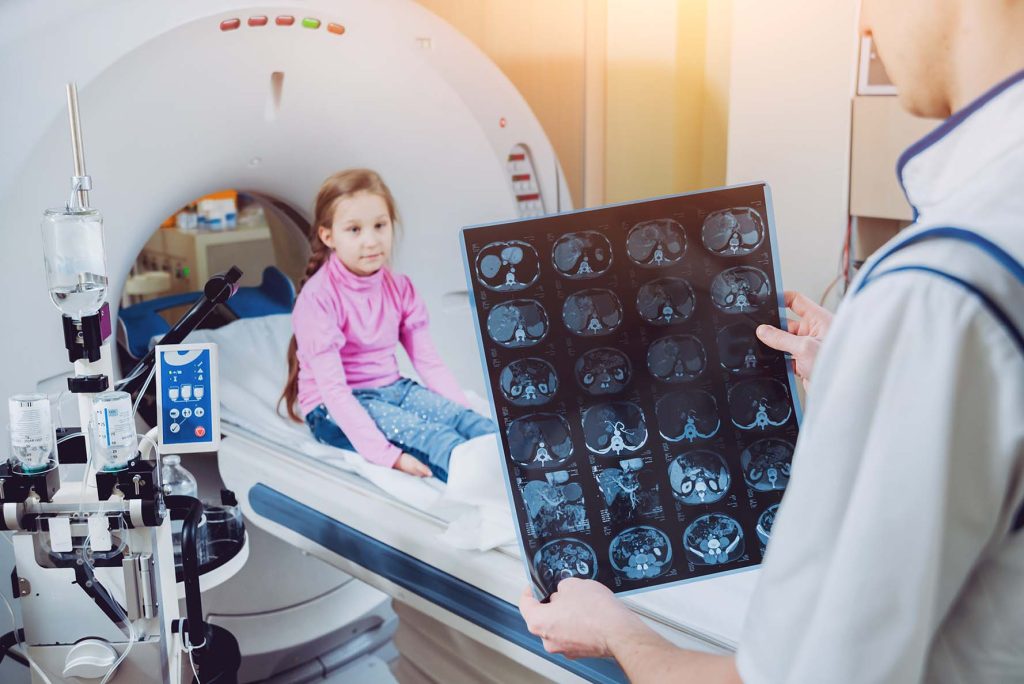Pediatric Neurosurgery
Pediatric Neurosurgery is a unique specialty. Pediatric Neurosurgeons have the opportunity to intervene in a developing nervous system and repair injuries that will improve the quality of life of patients in the future.

Object of study
The field of Pediatric Neurosurgery is characterized by the presence of certain diseases of the nervous system in a patient whose mental capacities are in development; therefore, the objective of the Pediatric Neurosurgeon is to treat these conditions and for the pediatric patient to continue with adequate psychomotor development.
Those that are present from birth, where we can find:
- Congenital bone malformations known as craniosynostosis, with a frequency of three to five patients in 10,000 births and are characterized by a deformity in the skull which does not allow the brain to grow properly.
- Malformations of the brain itself such as hydrocephalus, a disease where there is an alteration in the production, absorption or distribution of cerebrospinal fluid and occurs in one to two patients in 1,000 births.
- Alterations in the development of the spinal cord, known as dysraphism with an incidence of two to three per 1,000 live births, which may present neuroinfection or subsequent alteration in mobility or walking.
- Blows or falls that lead to head trauma of varying intensity. Head trauma is the main cause of admission of pediatric patients to the emergency room and the main cause of mortality between 6 and 14 years of age. Treatment is focused on preserving life, subsequently, neurological function and ensuring that the patient continues with adequate psychomotor development; for this purpose, a team of professionals specialized in the management of children is required.
- Accidents of vascular origin, characterized by the presence of bleeding or cerebral infarction, with a frequency of six in 100,000 pediatric patients, and which are sometimes not diagnosed due to their low frequency and which can present a mortality rate of 10% and a recurrence of up to 20%.
- Conditions classified as chronic and disabling include difficult-to-control epilepsy, which occurs in patients who, despite having adequate pharmacological treatment, do not respond in 15% of cases and may require surgical intervention.
- Tumors or neoplasms of the central nervous system, which in children represent the second cause of cancer, preceded only by leukemia. These represent real challenges for our team of specialists (neurosurgeon, oncologist, radiotherapist, psychologist and rehabilitation specialist), who seek a cure or, where appropriate, control of the disease with an adequate quality of life and psychomotor development.
The purpose of surgery in pediatric patients is to perform the planned procedure with the least possible damage to the surrounding healthy tissue and with the least possible bleeding. To do this, we use the most advanced technology in order to improve the result of the procedure and reduce the risks and complications that this procedure entails with the ideal of minimal invasion.
The ideal of minimal invasion consists of performing the appropriate surgery with the least possible damage to the surrounding healthy tissue. To achieve this, first of all, we use microsurgery in most of our surgeries, which consists of the use of surgical microscopes that allow an enlargement of the surgical field and help us to respect the surrounding healthy tissues.
We also have the neuronavigator, which allows us to work with images such as magnetic resonance on a computer prior to surgery and transfer the information to an infrared system that will allow us to locate the lesion in the patient during the procedure.
In cases where the lesions are smaller or depth electrodes need to be introduced, we have the stereotactic arch, a system attached to the patient’s skull that, using a Cartesian system, allows us to accurately locate the place where we want to either take a biopsy with a needle or place an electrode.
The neuroendoscopy equipment allows us, by means of a camera and transmitting to a monitor, to navigate inside the brain and resolve conditions such as hydrocephalus without the need to place a valve or, if necessary, take biopsies of lesions that present diagnostic doubts.
We must not forget the use of intraoperative electrophysiology that allows us to record an irritant focus in an epilepsy patient or assess the functional integrity of the nervous system during cranial or spinal surgery.
The medical group is made up of specialists who completed the specialty in neurosurgery and subsequently, a subspecialty in pediatric neurosurgery with university recognition in reference centers for pediatric patients with central nervous system disease.
Our members are active members of the Pediatric Neurosurgery Section of the Society of Neurological Surgery.


